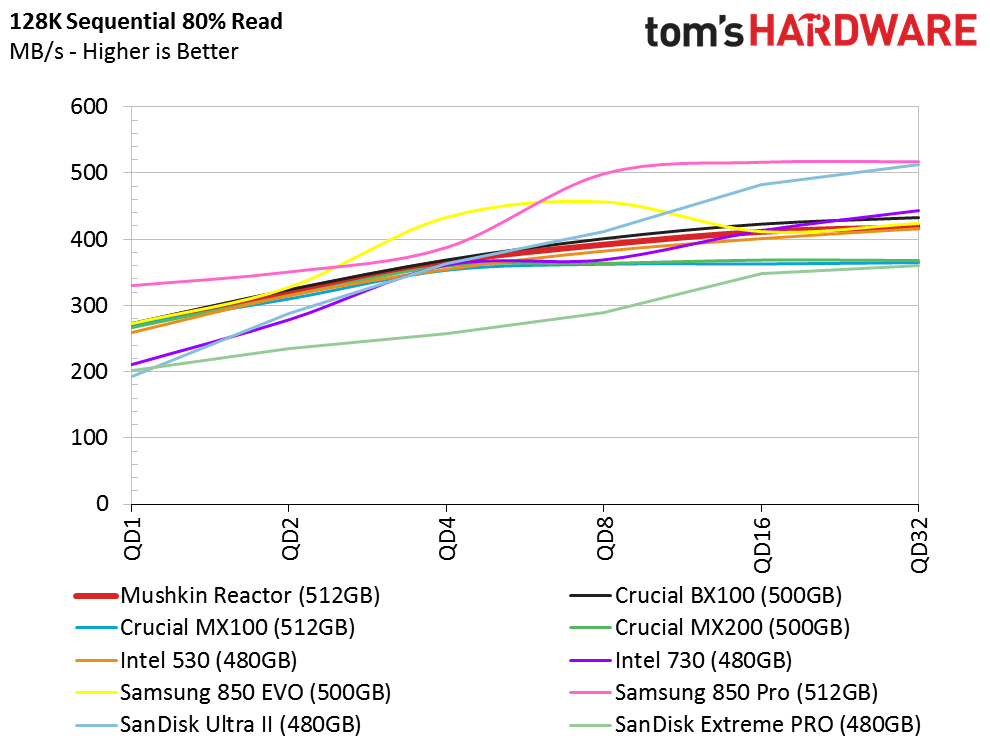Mushkin Reactor 512GB SSD Review
Mushkin's 1TB Reactor is among our Best Picks in SSDs. Today we look at the low-cost 512GB drive powered by Silicon Motion's four-channel SM2246EN.
Why you can trust Tom's Hardware
80% Sequential Read Mixed Workload
Our mixed workload testing is described in detail here, and our steady state tests are described here.
A handful of outstanding commands and some light preconditioning with 80% reads is one of the most relevant ways to measure both sequential and random performance. On this chart, we see that most of the drives fall into the same performance range with only a few outliers at QD4. Pay the closest attention to QD2 and QD4, even though we take our measurements out to enterprise-class levels.
At QD2, only the Samsung 850 Pro stands out with higher performance than the other SSDs in our comparison group. Several drives prove to be slower, but Mushkin's Reactor lands in the group of more average products.
Get Tom's Hardware's best news and in-depth reviews, straight to your inbox.
Current page: 80% Sequential Read Mixed Workload
Prev Page Random Write Next Page 80% Random Read Mixed Workload
Chris Ramseyer was a senior contributing editor for Tom's Hardware. He tested and reviewed consumer storage.
-
SuperVeloce Those 512 and 1TB are made perfectly for my steam folder, cheap and large. Now we need to wait for someone to launch it to EU marketReply -
jessterman21 Been eying this drive and the BX100 500GB for a few months now - waiting to pull the trigger on whichever's cheaper. The extra latency worries me, but in a gaming/media rig should it really matter? Those two drives are literally the same in all other tests.Reply -
Eggz Cool. This seems like a pretty good option for a gaming computer. I wouldn't use it for a photo editing rig, or any other media-based computer (especially not database oriental computing), but games are pretty easy on drives, and these come in at a decent price while offering plenty of storage space.Reply -
agentbb007 Tough sell considering the 500GB Samsung 850 Evo is $178 on Amazon with free prime shipping and seems to give better performance, unless I'm missing something?Reply -
Saberus Granted it's not the absolute best, but it's not bad, especially at the price. I think the edge connector is a brilliant idea, and wonder why there aren't more companies using it, it eliminates a point of failure where the solder joints were.Reply -
geopirate agentbb007 this drive is $88 for 500gb vs your $178 (less than half the cost) that won't be noticeably slower in a typical usage environment. Is that what you're missing?Reply -
geopirate agentbb007 this drive is $88 for 500gb vs your $178 (less than half the cost) that won't be noticeably slower in a typical usage environment. Is that what you're missing?Reply -
shrapnel_indie Reply16122495 said:I think the edge connector is a brilliant idea, and wonder why there aren't more companies using it, it eliminates a point of failure where the solder joints were.
I guess because in some ways its so old school. (It saved money back then too.) Back in the "Home Computer" days card-edge connectors were used for expansion connections (on one side of the connection.) Retro consoles used it too with game carts. The PC used it then, and even still today, for expansion AND adding graphics. Back in the day Floppy drives, primarily 5.25" and larger used such a connection for data (and a molex for power.)
If that patent ever gets challenged, I dunno if it will hold-up because of all of that. In Modern storage though, the connector is, currently, unique though.
